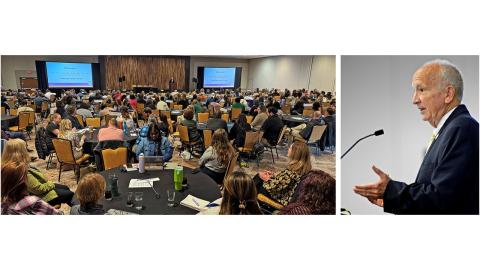Treatment Court Leaders Convene at Building Recovery Capital Conference in Winston-Salem
Article contents

Leaders of local recovery courts convened in Winston-Salem, N.C., this week for the Building Recovery Capital conference to train together in best practices, learn from peers statewide and national experts, and hear a new vision for North Carolina’s treatment courts.
Chief Justice Paul Newby thanked members of recovery court teams from counties across the state, including court employees, community coordinators, probation and parole officers, judicial officials, and other local leaders, for the extra hours and intensive work required of their commitment to offering recovery courts in their communities.
"Our shared commitment to the successful expansion of recovery courts is building a more trauma-informed Judicial Branch in service to North Carolina communities affected by addiction epidemics, adverse community environments, and adverse childhood experiences (ACEs),” Chief Justice Newby said.
More than 300 conference registrants, including Superior and District Court Judges, District and County Attorneys, Defense Attorneys, Probation Officers, Treatment Professionals, Peer Recovery Support Specialists, Veterans Services, Educators, Housing Specialists, and more, from recovery court teams across North Carolina participated in group trainings and over 30 breakout sessions. Topics included predictive analytics for community supervision, data-driven improvements for recovery courts, comprehensive case plans, services for veteran communities, administrative planning and sustainability, target populations, and more.
“I’m extremely excited and grateful for the N.C. Recovery Court Conference that took place this week; it was packed with the kind of information and inspiration useful to further empower recovery professionals devoted to helping individuals battling controlled substance misuse, overcome those obstacles toward the goal of achieving sobriety and maintaining a drug-free lifestyle,” said JMARC Advisory Committee Chairman Judge James Faison.
North Carolina Administrative Office of the Courts (NCAOC) Director Ryan Boyce joined other state agency leaders, Deputy Secretary Tracy Lee with the Department of Adult Corrections; Kellie Crosbie, Director of the Division of Mental Health, Developmental Disabilities and Substance Use Services; and Secretary Jocelyn Mallette with the North Carolina Department of Veterans and Military Affairs, on a panel to discuss a new vision for recovery courts developing through the Judicial Branch’s focus on trauma-informed courts.
Director Boyce said the NCAOC’s growing team of recovery court experts were working with state agencies, the Judicially Managed Accountability and Recovery Courts (JMARC) advisory committee, researchers at the UNC Collaboratory and University of North Carolina at Wilmington, legislators, and other partners, to advance a new vision for treatment courts.
“Our mission is to help recovery court leaders better serve their communities, not only expanding opportunities to meet the highest need in each county but connecting and improving the sustainable administration of services with our partners,” Director Boyce said.
Chief Justice Newby convened the ACEs Task Force (Adverse Community Environments, Adverse Childhood Experiences) in 2021.
Learn more about the ACEs Task Force and the Advisory Committee on Judicially Managed Accountability and Recovery Courts.
The Building Recovery Capital conference was hosted by the North Carolina Administrative Office of the Courts and its partners in Winston-Salem, N.C., April 9-11, 2025, through the support of federal grant funding. There are currently 83 treatment courts in North Carolina, that include adult, mental health, veterans, family, and juvenile courts. Since 2021, 33 new recovery courts have begun hearing cases (or will soon begin), representing a 66% increase in the past four years.